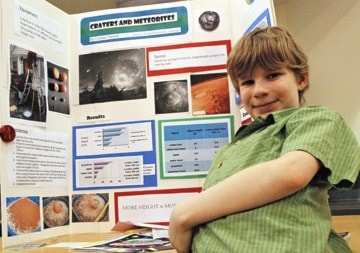The SD20 Science Fair at Trail Middle School on March 9 drew a wide range of creative talent from around the region, including a great showing from Kinnaird students who answered questions such as: ‘What would dinosaurs look like today if there were still alive?’ and ‘What size of crater might a meterorite make?’
Students from seven elementary schools — five district and two independent — and two secondary schools entered more than 80 projects that were presented by more than 100 students.
Judges awarded projects in Grades 4, 5, and 6/7, although projects were entered by students from Grades 1 to 11. Denise Flick, the District Learning Coordinator who was instrumental in organizing the event and has been involved in science fairs in the mid 1990s, said selecting students for awards was very difficult.
“Today was an extraordinary success,” she said. “We have not had this many projects in years.”
“I credit it to a number of champions at different schools, teachers who are champions of science who mentored their students and enable them to get the resources and organization they needed. And, of course, to the parents who are so keenly interested and make it possible for their kids to take part,” she said.
As the judges found, it is difficult to single out projects from such a broad and interesting set of submissions, but highlights included Kinnaird Grade 2 student Ciaran Tanner’s meticulous investigation of crater sizes made by meteors.
The inquisitive young man dropped a variety of different sized “meteors” from different heights off a ladder into different qualities of sand pit, and measured the craters that resulted.
Grade 3 students Olivia Kozak and Jake Boettchter asked whether house colour affects temperature inside, while Casey Alexander and Trinity Kentrop in Grade 4 found ways to use vegetables, from carrots to cauliflower, to make paper and tied for second place with Zoey Crockart’s project, ‘How to come clean?’
Kinnaird students took first place as well, with a tie between two absorbing questions, Chloe Ahlefeld’s ‘How much water do you eat?’ and Tara and Jamie Horning’s ‘How absorbant are different paper towels?’
Some projects were especially imaginative, such as Grade 5 students Ginger Pearce and Gracie Miner’s thought experiment to reconstruct what dinosaurs would look like today if they were still alive today.
The next big event is the West Kootenay Regional Science Fair on April 2 at Mary Hall at Selkirk College’s Nelson campus. It’s open for registration for all students in school districts No. 20, 8, 51, and 10, with no prequalification required — meaning participants are not required to have participated in a division-level fair.
The Kootenay Association For Science and Technology (KAST) will give $1,500 of assistance with travel costs for the regional winner who gets to go to the Canada-wide science fair in Toronto later this year.
The regional science fair also features a popsicle bridge building competition, an initiative of the Association of Professional Engineers and Geoscientists of BC (APEGBC). Kids get a standard kit from APEGBC, build a bridge, and bring it in for testing to see how much weight it can hold. Testing is a spectacular affair that involves loading the bridge to the point of collapse.
While supplies last, bridge kits are available from Empac Engineering — 1402 Columbia Ave. in Castlegar — and more information is available from APEGBC’s Mark Sirges at 250-368-2504.]
Register online for the regional science fair at secure.ysf-fsj.ca/sfiab/westkootenayboundary.
